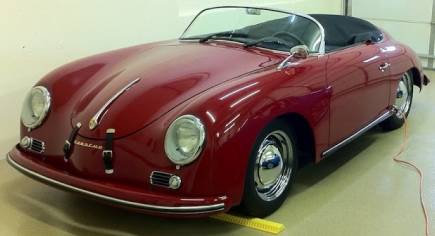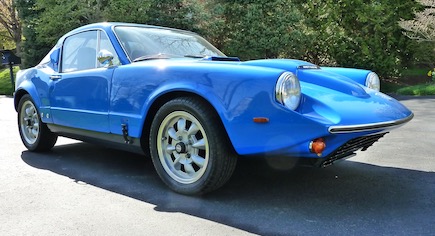Electric motor
The electric Porsche 356 is propelled by an alternating current (AC) electric motor specially designed for torque output at high revolutions in order to achieve top speeds over 100 mph.

HPEVS AC50 motor, Curtis controller and harness

Clutch on motor adapter; note small magnets
The motor is regulated by a controller that can handle up to 550 amps and 125 volts which closely matches the specification of the lithium battery pack.
The motor cools itself with an interior fan that runs off the rotating shaft, but the controller requires a heat sink and auxiliary cooling fan for peak load performance.
The spindle end of the motor mates to the transaxle with a custom-machined adapter and taper lock along with the clutch and flywheel. Four large bolts hold the adapter assembly to the transaxle housing which is securely mounted on the steel chassis.
This design retains the classic 4-speed shift pattern of the gasoline original.
Two small magnets, 180 degrees apart, allow the Westach sensor to pick up rotational speed for the RPM tachometer display.
Peak torque shift points are 22 mph (1st), 36 mph (2nd), and 60 mph (3rd). Torque drop off begins over 85 mph. At the top speed of 110 mph, the motor still produces about 55 ft.lbs. of torque (63% of maximum).
With modified ratios that exploit the RPM profile of the electric motor, the lithium electric 356 handles much like the 1957 classic.
A special mounting plate bolts the motor to the transmission housing.
The Cars
Porsche 356 Speedster

The iconic Porsche Speedster proved to be an excellent EV conversion candidate due to its low weight, relatively simple design, and ample front/rear compartments for mounting pristmatic lithium battery cells. Weight distribution was improved over the original rear engine configuration with better acceleration and overall performance.
Saab Sonett

The unusual fiberglass Sonett, originally powered by a Ford V4 engine, combines a low center of gravity and front wheel drive, optimal for our high performance EV conversion. Without the need to accomodate a long drive train, the space behind the two seats was used for additional batteries. The original four-speed transmission remains intact along with the braking system.